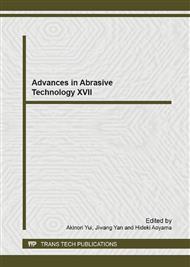p.720
p.726
p.735
p.741
p.747
p.753
p.758
p.764
p.770
High-Speed Capturing of Stress Distribution of Workpiece under Ultrasonically Assisted Cutting Condition
Abstract:
This paper reports the stress distribution inside the workpiece under ultrasonic vibration cutting (UVC) condition. Many researchers have reported the improvement of tool wear, burr generation and surface integrity by reduction of time-averaged cutting force under UVC condition. However general dynamometers have an insufficient frequency band to observe the processing phenomena caused by UVC. In this paper, stress distribution inside the workpiece during UVC was observed by combining the flash light emission synchronized with ultrasonically vibrating cutting tool and the photoelastic method. Instantaneous stress distribution during UVC condition was observed. Because UVC induced an intermittent cutting condition, the stress distribution changed periodically and disappeared when the tool leaved from the workpiece. It was found that instantaneous maximum cutting force during UVC condition was smaller than quasi-static cutting force during conventional cutting when the cutting speed was less than 500 mm/min.
Info:
Periodical:
Pages:
747-752
Citation:
Online since:
September 2014
Authors:
Price:
Сopyright:
© 2014 Trans Tech Publications Ltd. All Rights Reserved
Share:
Citation:


